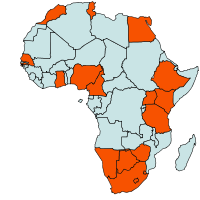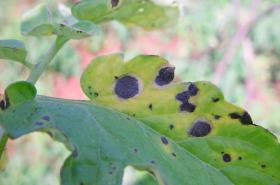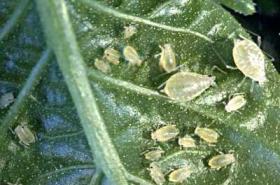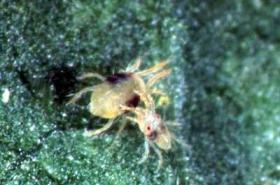 |
African Nightshade
Scientific name:
Solanum villosum
Family:
Solanales: Solanaceae
Local names:
Mnavu (Swahili), Managu (Kikuyu), Namaska (Luhya), Osuga (Luo), Isoiyot (Kipsigis), Kitulu (Kamba), Ormomoi (Maa), Ndunda (Taita), Nsugga (Luganda)
Common names:
Black nightshade, narrow-leaved nightshade
Pests and Diseases: Aphids
Bacterial wilt
Early blight
Spider mites
|
 |
| Geographical Distribution of African Nightshade in Africa |
There are several species with black berries, but the most popular are those with orange berries belonging to Solanum villosum. This group of species is often erroneously referred to as Solanum nigrum, a poisonous plant from Europe that is not usually grown in Africa (AVRDC 2003).
The leaves are eaten as a cooked vegetable, often mixed with other vegetables and the fresh fruit is also consumed. Some Solanum varieties are preferred for their bitter taste while others are considered 'sweet', particularly after being boiled and the water discarded. The raw leaves contain 4% protein, 6% carbohydrates and are moderately high in vitamin C.
Solanum species that are found in Kenyan vegetable gardens include S. macrocarpon, S. scabrun and S. villosum.
Solanum plays an important role in traditional medicine in Africa and elsewhere, but the leaves are considered poisonous in some areas of the world so one should be careful about obtaining seeds for planting.
The soil in the nursery should be loosened and enriched with decomposed manure. Seeds should be mixed with sand and/or ash for uniform sowing. Sow the mixture thinly, either by broadcasting or in rows, 15 - 20 cm apart and cover with a fine layer of soil. After sowing, the bed should be mulched with tall grass or a similar material to retain moisture. This mulch can be removed once the plants are 3 cm. Transplant when seedlings have 6 true leaves and are 10 - 15 cm tall. The spacing should be 20 cm in the row by 40 cm between the rows.
If complete harvesting is practiced, spacing can be as close as 10 x 10 cm and plants are uprooted. This method is mainly used when there is less than 2 months before the main staplefood crop will be planted. Roots of these crops can be kept in water to keep the plants fresh.
Picking should be done very early in the morning and the produce sold the same day. Alternatively, the crop can be harvested late in the afternoon and placed on plastic sheets or banana leaves. These should be tied in small bundles. The flowers should be removed before the crop is taken to market. Water these bundles sparingly to retain freshness.
1/4 kg amaranth (1 large bunch),
2 medium tomatoes, chopped,
1/4 kg spider plant (1 large bunch),
1/2 cup groundnut powder,
2 table spoons shortening or cow fat,
3 table spoons water,
1 medium onion, chopped and
1 tsp salt
Preparation. Clean and wash both the green vegetables, chop the vegetables, onion and tomatoes and set aside for later use. Heat the shortening or fat and fry the onion until soft and slightly brown. Add the tomatoes, stir and cook until soft. Add the green leafy vegetables, stir, cover and simmer for 20 minutes, stirring occasionally. Mix the groundnut powder into a smooth paste and add to the simmering vegetables, then salt to taste. Cook for an additional 5 minutes. Preparation yields 4 to 6 small portions and is best served while hot with ugali or mashed bananas.
1 kg nightshade leaves,
1 medium tomato, chopped,
1 cup water,
1 tablespoon salt,
90 ml cream,
2 tablespoons vegetable oil and
1 medium onion, chopped
Preparation. Pinch the leaves of nightshade from the main stalk while retaining a very small leaf stem. Wash the leaves in a basin and drain off the water. Bring the water to boil and put the leaves into the boiling water for 25 minutes, then remove from fire and drain excess water. Heat vegetable oil in a pan and add the chopped onions, stirring occasionally until the onions are soft. Add tomatoes and the boiled nightshade leaves and cook for 2 minutes, stirring occasionally. Add the cream and 1 litre of water, cover and simmer for 5 minutes. This preparation makes four servings and is best served while hot with ugali. An alternative recipe involves the addition of 1 to 2 cups of other traditional green vegetables, particularly spider plant or amaranth, with the nightshades.
©www.formatkenya.org
Early blight
Leaf spots of early blight are circular, up to 1 cm in diameter, brown, and often show a circular pattern which distinguishes this disease from other leaf spots. Early blight thrives best under warm wet conditions. Leaf spots first appear on the oldest leaves and progress upward on the plant. Entire plant could be defoliated and killed.
Controlling early blight once it has established is very difficult. The most important way of controlling early blight is attempting to prevent its establishment and further spread.
- Rotating with other crops like amaranth is essential. Do not rotate with tomato, potato or peppers as these belong to the same family and susceptible to the same diseases.
- In areas with a high humidity, wider plant spacing should be used.
- Practice good field hygiene. Remove infected leaves during the growing season discard all badly infected plant debris at the end of each season.
- Use certified disease-free seeds
- When using own seeds, hot water treat the seeds. For more information on hot water treatment click here

Early blight on tomato leaflet. Similar symptoms on African nightshade
© A.M. Varela, icipe
Aphids (Aphis spp.)
Aphids are a major pest, causing leaves to curl and become unattractive to customers.
Aphids feed by sucking plant sap. Small aphid populations may be relatively harmless, but heavily infested plants usually have wrinkled leaves, stunted growth and deformed pods. Plants, in particular young plants, may dry out and die under heavy aphid attack. Heavy attack on older plants may cause crop loss by decreasing flower and seed production. Damage may also reduce seed viability.
- Conserve natural enemies. They are important in natural control of aphids. For more information on natural enemies click here
- Monitor regularly the crop.
- Whenever necessary spray only affected plants (spot spraying).
- Use biopesticides that are not harmful to natural enemies (for instance neem, ashes, soapy water). In Kenya, foliar sprays with neem products such as Neemroc® (1-3%) and Neemros® water extract (50g/l) controlled the black bean aphid on French beans (Maundu, 1997). For more information on biopesticides click here

Adult wingless female aphids are oval-bodied, 1 to 2mm in body length, of very variable colour.
© Magnus Gammelgaard
Spider mites (Tetranychus spp.)
The plant's leaves and growth tips are susceptible to mites (very small, sucking arthropods) that result in twisted growth and low productivity.
Generally, spider mites feeding may cause reduction in plant growth, flowering, number and length of berries, and number of seeds per berry. Damage is most severe when mites attack young plants. Mite damage may be particularly severe during the dry season.
- Avoid planting next to infested fields.
- Avoid use of broad-spectrum pesticides, in particular pyrethroids; this may lead to spider mite outbreaks.
- Use overhead irrigation or wash plants with a strong jet of water to knock off mites and destroy their webs. Be sure to spray the underneath of the leaves. However, this should be done early in the day to allow the foliage to dry. Wetness of the foliage for an extended period is conducive to development of fungal diseases.

Two-spotted spider mite (Tetranychus urticae). The adult female is 0.6 mm long. The male is smaller.
© Image supplied by Warwick HRI, University of Warwick
- AVRDC, (2003). International Cooperator's Guide. Narrow-leaved Nightshade. www.avrdc.org
- Edmonds, J.M. and Chweya J.A. (1995). Black nightshades, Solanum Nigrum and related species. Promoting the conservation of underutilized and neglected crops. 15. Gatersleben: IPK/Rome: IPGRI. ISBN 92-9043-321-3 www.bioversityinternational.org
- FORMAT, (2003). Forum for Organic Resource Management and Agricultural Technologies. Organic Resource Management, Chapter 17 www.formatkenya.org
- IPGRI, (1997). Traditional African Vegetables. Promoting the conservation and use of under-utilized and neglected crops. The proceedings of a conference held by the International Plant Genetic Resources Institute (IPGRI), August 1995, ICRAF, Nairobi, Kenya. 171 pp. www.bioversityinternational.org
- Maundu, P.M., Ngugi, G.W. and Kabuye, C.H.S. (1999). Traditional Food Plants in Kenya. Kenya Resource Centre for Indigenous Knowledge. National Museums of Kenya, Nairobi. 270 pp.
- Ministry of Agriculture and Rural Development, Kenya (2000). Local and export vegetables growing manual. Reprinted by Agricultural Information Resource Centre, Nairobi, Kenya.
- Ouma, M.A. Indigenous vegetable production and utilization in Suba district, Kenya: Improving health, unlocking the wealth in Suba district. BioVision - T.T.U, ICIPE. Unpublished.
- Woomer, P.L. (2002). The Traditional Green Vegetable Cookbook. Forum for Organic Resource Management and Agricultural Technologies. Nairobi. 46 pp.
- Seeds are marketed by Simlaw Seeds in Nairobi under the name Black Nightshade in 25 gram packets and another source with particularly large, tasty leaves is available from SACRED Africa, Bugoma, Western Kenya.
- Seeds are also available at Katumani Research Centre, KARI (karikatumani@yahoo.com; +25444420495).